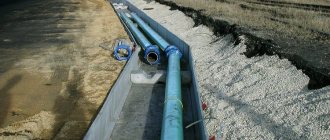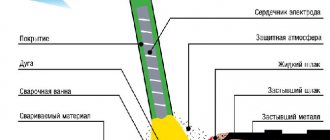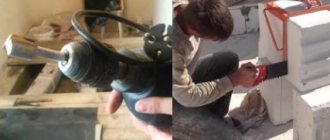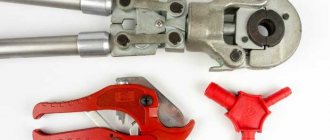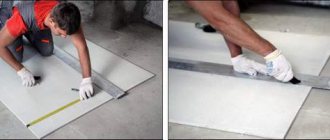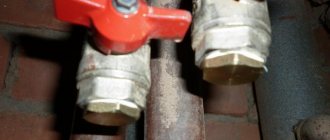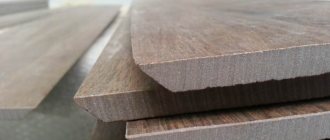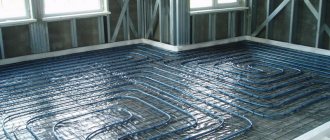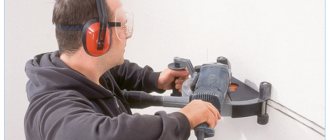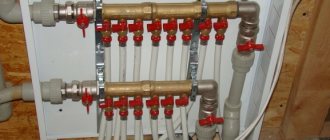Metal-plastic pipes are capturing an increasingly larger segment of the plumbing market, so the issue of their maintenance is becoming more pressing. There is an opinion that if it is necessary to replace such pipes, the entire pipeline must be replaced. But this opinion is wrong.
The products are easy to cut and replace in parts without harming the overall plumbing or heating system. Below we discuss how to properly cut metal-plastic pipes.
Cutting methods
There are several basic cutting methods, which directly depend on the tool used. First of all, you can cut products:
- Knife for efficient cutting of metal-plastic pipes. In this case, the knife should be self-sharpening.
- Hacksaw for metal. The simplest method, which, however, will require a lot of effort and time from the performer. In addition, the edges may turn out torn.
- Scissors.
- Pipe cutter.
When using some tools, the edges of the cut are quite uneven, and particles of material can subsequently cause clogging. The best way is to use special scissors that cut evenly without leaving torn edges. These scissors can cut objects with a diameter of up to 40 mm.
Important! In this case, you don’t have to put in any special effort, since the tool is specially designed for such work and has special blades. These blades easily cut through plastic pipes anywhere.
For larger diameter products, it is better to choose a pipe cutter. Pipe cutters come in telescopic and ratchet types. The first type is based on the operation of a special roller that rolls along the entire circumference. The second type is more similar to scissors, as it uses a lever system with two handles.
Guillotine Rothenberger ROCUT XL 125
The cutter is manufactured by the same manufacturer as the previous model. Suitable for use in any part of the pipeline. The blade has a V-shape, which facilitates the process of cutting workpieces. It is made of alloy steel. The cutting edge angle is optimized, making the tool even easier to use.
The lower clamping device of the guillotine cutter is convenient. It folds completely. Therefore, you can use this pipe cutter even in cramped trench conditions. The model is suitable for cutting pipes with a diameter of up to one hundred and twenty-five millimeters. Can be used to work with workpieces made of all types of plastic.
The tool has proven itself well. Among models of a similar type, it stands out due to its versatility and ease of use. Blade replacement is quick and efficient. If you decide to opt for a guillotine-type cutter, this option will be the most optimal.
How to cut metal-plastic pipes
Metal-plastic pipes have a number of advantages over their competitors. They are much lighter than metal and much more resistant to oxidation than copper. They are easy to replace and easy to shape into the desired shape.
You can create a pipeline of any shape. Well, the main advantage is the cost. It is much lower than that of copper pipes. And the quality is approximately at the same level.
During operation, it may be necessary to cut pipes. For this, a special tool is used that is designed to work with such material.
To increase the effectiveness of the procedure, it is recommended to properly prepare the pipe and tools before work. Let's look at the main features of metal-plastic pipes and how to cut them.
Preparing the pipe and necessary tools
The tools used are the cutting device itself, measuring tapes, adjustable wrenches, seals and some other things. All this must be in an accessible place at the time of work.
Sometimes it is necessary to scrape the outside of the reinforced coating to make the cutting process easier in the next step. For stripping, a coupling with blades is used, which allows you to get a perfectly even cut and get rid of the polymer layer. This is necessary for welding work, which will most likely be carried out during pipeline installation.
Important! When working, it is necessary to cut off exactly as much material as is needed to attach the fitting for metal-plastic products.
Milwaukee C12 PPC-0 Cordless Cutter
The model is produced by the American company Milwaukee Electric Tool, specializing in the manufacture of professional tools. The cutter is suitable for working with pipes with a diameter of up to fifty millimeters. When cutting workpieces, strong pressure is created. Therefore, working with the tool is easy. It takes three seconds to cut a PVC pipe of the maximum diameter allowed for this pipe cutter. The gear housing and gears are made of durable metal. Due to this, maximum torque is achieved.
The cutting speed can be adjusted. The device is equipped with a good battery. One charge is enough to make two hundred cuts. The battery is reliable. It is characterized by a long service life. For small diameter pipes, this tool will be the best choice. If you do not want to buy a pipe cutter for each size of workpiece, stop choosing more universal models.
- Article rating:
Save to:
How to cut a plastic sewer pipe Link to main publication
Related publications
Installation of stainless steel pipelines Septic tank without electricity and pumping How to disconnect cast iron sewer pipes Insulation for pipes PPU shell Is it possible to use an asbestos-cement pipe for a chimney Sealing threaded connections in plumbing How to change pipes in the bathroom yourself? How to remove the coarse water filter? How to bend a pipe yourself without a pipe bender? How to find artesian water on the site? How to remove the gooseneck from a kitchen faucet? How to straighten an aluminum tube?
Tools for cutting metal-plastic pipes
The following tools will be useful in the pipe cutting process:
It is important for the master to determine in advance what he will use to cut metal-plastic pipes. The most important tool on the list is scissors. Everything else is necessary for special preparatory work.
There is no need to apply much force during the cutting process. You just need to fully control every movement. If you do not pay due attention to control, you can easily cut off the excess part.
If during the cutting process it is necessary to bend the product, it is not recommended to do this by hand. This can easily damage the aluminum layer that is inside. It is better to take a professional pipe bender and perform the operation with its help.
Using the wrong tools on one area can affect the entire network, resulting in high repair costs.
Important! Special scissors are usually found in the welding kit. But they can be purchased separately. The price of this tool is not so high as to save on it.
Before you start cutting directly, you need to very clearly measure the part where the unit will be divided. To do this, use a tape measure or ruler, as well as a bright marker. A faded pencil may simply not be visible, especially if there is not enough lighting in the room. The mark can be made with a knife, leaving a scratch.
During operation, pieces of plastic and aluminum may fly in different directions. Therefore, it is necessary to use protective equipment in the form of glasses and special clothing.
Scissors
This type of cutter is popular. It is used for cutting pipes of small diameters. The operation of this tool has the following features:
- the cutting part of the pipe cutter in many models has a special rail, which greatly facilitates the procedure;
- you can work with scissors with only one hand, with the other you can perform other manipulations;
- when installing water supply systems, you can quickly get tired if you spend a long time cutting workpieces, since solving the problem requires significant physical effort;
- select scissors carefully; low-quality models tend to break after two hours of work.
If the workpiece was damaged during facing, remove this area. Otherwise, you will not be able to create a tight connection. The tool is used for pipeline repair purposes. Using it, you can quickly remove the damaged part and replace it with a whole pipe.
Cutting with scissors is performed according to the following rules:
- Place a mark on the location of the future cut.
- Place the main blade over the marker mark. For precise positioning of scissors, use a special slot.
- Press the handles to carefully cut into the pipes. Next, increase your efforts.
- Do not make sudden movements with your hand while working. This will cause the cutting component to jump off the guide. As a result, you will have to start all over again.
- Place the base blade accurately. It should be tightly to the workpiece.
Cutting technique
Self-cutting can be carried out with products with a diameter of 5 to 30 cm. So, if the product does not fall within these boundaries, it is best to turn to professionals.
When carrying out any such manipulations, it is important to remember the basic rules:
- Metal-plastic products are very sensitive to temperature, so some problems may arise in hot or cold weather. The material shrinks and expands easily, making it difficult to determine the true dimensions.
- Metal-plastic, like polypropylene pipes, can be cut with any available means. But in order to avoid various negative consequences, it is best to do this with special tools.
- An excellent tool is a special self-sharpening knife. But if you plan to carry out work to replace one section with another, it is better to abandon the tool in favor of scissors.
- The material is quite fragile. Applying too much force can result in cracks or specific deformations. The permissible load can be seen in the product passport, which was issued at the time of installation of the water supply system.
- The type of cutting directly depends on the proportion of metal and plastic in the product. If there is more metal, then when cutting there should be as little friction as possible. Otherwise, a large proportion of plastic means a higher intensity of work with high friction.
- Before starting work, you must make sure that there is no water or gas flowing through the pipe. You need to turn off all the taps and wait a little.
- After completing the work, you need to thoroughly clean the inside of any debris that could lead to blockages or break specialized equipment.
The use of electronic cutting tools is not considered reasonable, since the specific material is not designed for this. You can do it manually.
Source: znatoktepla.ru
Types of pipe cutting equipment
Each of them has its own merits. The most suitable equipment should be selected based on the volume of work and its complexity.
When choosing equipment for cutting polypropylene pipes, the main attention should be paid to two points:
- The blade must be made of alloy steel.
- Each pipe cutter model has two indicators - the minimum and maximum pipe size. This range should be selected so that it is sufficient to complete the work.
The body material of such equipment is usually made of metal. And it's best when it's aluminum, not steel. A pipe cutter with aluminum handles is light in weight and requires less effort to operate. Soft polypropylene pipes do not require excessive effort when cutting. An aluminum tool will cope with the resulting loads without problems.
A pipe cutter can have replaceable or non-replaceable cutters. Sooner or later they will wear out. In the second case, the tools will have to be purchased again. However, if the cutting apparatus is needed for a one-time job, then it is better to take a cheaper model with permanent equipment.
Briefly about the drainage system
The sewerage system is a description of all components and the principle of operation of the system as a whole and for individual units. Subdivided:
- Internal – located in the building.
- External - laid outside buildings.
Internal
Internal sewage system:
- Plumbing fixtures (sources of dirty water): toilet, bidet, washbasin (kitchen sink), bath (shower), washing machine and dishwasher.
- Siphons and connection elements (transition couplings).
- Outlet pipes Ø 30–50mm. For toilet 100mm.
- Transition elements: fittings and couplings, check valve, revision.
- The main riser is an element that collects wastewater from all sources into one sewer pipe. The collector diameter should not be less than 100mm.
Installation of a sewage system indoors is regulated by regulatory documents: SNiP (Sanitary Norms and Rules) 3.05.01–85 “Internal sanitary systems.”
Outdoor
The external system includes:
- Sewage line made of pipes Ø 100–200 mm (for individual housing).
- Overflow (inspection) wells.
- Couplings, fittings.
- Wastewater receiver (cesspool, septic tank, biotreatment station).
The installation of sewerage outside the building is regulated by SNiP 2.04.03–85 “Sewerage. External networks and structures."
Preparatory stage
First you need to collect everything you need to solve the problem.
The list of tools includes:
- calibrator;
- pipe bender;
- adjustable wrench;
- any fabric.
As you know, metal pipes include a layer of plastic and an aluminum bedding. They are firmly welded together using laser welding. The frame is an aluminum tube. The core of the product is quite smooth.
However, experts still recommend cleaning the surface of the structure from possible irregularities before starting cutting.
To strip pipe products, it is necessary to use a coupling. The process of cleaning the surface of the product itself takes a little time.
Installation
The installation of internal sewerage and external mains is in many ways similar. The difference is in the materials used. For internal sewer systems, gray-painted collectors are used. The outer ones have an orange tint. This is due to the difference in external loads:
- Products located indoors are subject to their own weight and, periodically, the load from flowing liquid. Thermal heating is added to 60–90°C with a parallel chemical attack from the components of the effluent.
- Parts located outside the building are subject to:
- pressure from the mass of the covering soil;
- exposure to the weight of passing vehicles;
- experience forces from buildings located above;
- exposed to external temperature changes, from negative to positive.
Hence, the installation of internal sewerage is carried out with a predominance of polymer materials:
- PVC (polyvinyl chloride). More precisely, unplasticized PVC (PVC-U).
- HDPE (low density polyethylene).
- PPR (polypropylene).
The most in demand are PVC products. Installation of internal collectors is carried out by joining the narrowed part of the pipe and the expanded part (socket). Additional elements are used - fittings (reducing couplings, tees, elbows with an angle of 45° and 90°, bends).
Installation of sewer pipes is carried out with obligatory observance of the angles of inclination:
- For a Ø 50mm collector, the slope will be 2–3 cm per linear meter of length.
- For a product Ø 100mm, about 1–2 cm per 1 meter.
During installation or repair work, there is a need to cut a plastic part. Polymers do not have high hardness and strength compared to metal products. Therefore, they can be processed with most metalworking and mechanical tools. It is possible to cut a plastic pipe using:
- hacksaws for metal or with fine hardened teeth;
- triangular file;
- jigsaw (for diameters not exceeding 50mm);
- circular or reciprocating saw;
- grinder and other tools.
Installation of sewerage systems is carried out according to the rules based on the requirements of SP 30.13330.2012. In addition to observing the slopes, it is necessary to correctly distribute the points of attachment and connection. If technically possible, it is recommended to carry out hidden wiring.
Installation of sewer pipes indoors begins:
- from drawing up a work plan;
- execution of a sketch or drawing;
- determining the required dimensions of the collector;
- procurement of the necessary material;
- preparing a tool with which you can cut a plastic part.
At the end of the installation stage, the internal sewage system is checked visually. Next, it is necessary to flush the system with water in order to identify possible product defects or leaks.
Nuances of choice
First, let's look at the approximate cost.
A cordless pipe cutter for PP (polypropylene) pipes will cost about $250-300. This is an average corridor; if you wish, you can purchase such a device cheaper, around $170-200.
The price of a manual pipe cutter for polypropylene pipes brand RidGid is about $60. Depending on the country, manufacturer and diameter, the price of a pipe cutter for polypropylene pipes will start from $30-40 on average.
A roller manual pipe cutter for metal (corrugated or stainless) pipelines will cost from $35, and a chain pipe cutter for metal pipelines can be purchased for $55-60. It is worth considering that the second device has a larger diameter of use.
From the above it follows that the price of a pipe cutter for steel or stainless pipes directly depends on what material and what diameter the device is used for, and how the impact will be carried out.
Therefore, before you buy a pipe cutter for steel or polypropylene pipes, you should pay attention to a few tips. Some tips when choosing:
Some tips when choosing:
Roller pipe cutter
- If you need a tool for different types of materials, then you can take a closer look at models with a roller mechanism for rolled steel pipes. It can also be used as a pipe cutter for PVC pipes and copper structures.
- To save money, you should not use electrical appliances for household purposes - manual mechanisms are quite capable of coping with the task. True, you will have to work hard here, so for large volumes of work they are not the best solution.
- For thin-walled products made of soft metal or plastic, special scissors are quite suitable, but if the amount of work is large, your hand can quickly get tired.
- It is better to choose models where it is possible to rearrange blades of different strengths.
Application nuances
To prevent the pipe cutter from deteriorating, you cannot use it for materials that are not listed in the list of instructions.
Before starting work, it is necessary to lubricate the threads, axles and blade of the tool with mineral oils. The surface of the cut area must be cleaned.
The pipe is clamped between the knife and the rollers and then a cut is made around the pipe. Then you need to rotate the pipe cutter around the pipe until it is cut.
If you apply excessive force when clamping, when the first turn is made, the formation of knife marks in the shape of a helix is likely to form.
In this case, to avoid breaking the knife, it is better to make a new cut to the side and not correct the screw line.
If you feel that the tool is difficult to move, you should loosen the clamp.
Outdoor system installation
Installation of sewerage from plastic pipes outside the building is carried out, in most cases, inside an earthen trench. This is due to:
- the need to protect the plastic sewer structure from exposure to negative temperatures;
- rational use of the surface of the earthen area; protection from possible mechanical damage.
Installation of sewerage systems outside the trench is carried out:
- in the presence of high groundwater levels (wetlands);
- rocky or frozen soil (permafrost);
- other technical limitations.
Installation of sewer pipes on the site is carried out mainly in the warm season. This makes it easier to install sewer pipes - a more comfortable climate and the presence of thawed ground.
Products for external use - red pipes, are made of polymers. Parts can be cut or trimmed in the same ways as for structures for internal use. Installation of sewer plastic pipes is carried out on our own or with the involvement of a third party.
The method - how to cut the parts when installing sewer pipes indoors or outside the building, it is advisable to think about it in advance, before starting work. Otherwise, you may not have the necessary device or tool at hand, which will significantly complicate the process of installing the highway.
Source: hemkor.ru
PVC sewer pipe cutter
Today, a common material when creating heating, plumbing or sewer systems is plastic. It is very convenient to use pipes from it. They have many advantages over analogues made from other materials.
When installing plastic pipes, no complex equipment is used. This greatly simplifies the installation process. However, correct adjustment of different elements to the required dimensions can only be done using a cutter for PVC sewer pipes. You need to know how to choose this tool correctly.
Hacksaw
The first is a hacksaw. When they come to some object with a pipe and a hacksaw, they do this.
The result is straight edges. And when a pipe is inserted into a pipe, this rubber band is bitten on the edge, so plumbers have to do an additional operation, namely chamfering. This is done either with a knife, respectively, or the pipe simply rubs against the concrete, and a chamfer is obtained.
Why is this method good? It's a small instrument, relatively small. Although we see that ours is quite large and long, and without protection it cannot be moved. Well, if you want to round the edges, you will need a knife.
Avoid making these mistakes when installing compression fittings on polyethylene (HDPE) pipes
Polyethylene pipes are widely used by owners of country houses for connecting water supply to the house from the street main, for connecting well pumps, for piping surface pumps, or for installing summer irrigation water pipelines.
Polyethylene (HDPE) pipelines are assembled using compression fittings:
There is an opinion that even a child can assemble a compression fitting. There is nothing simpler - unscrew the nut, stick the pipe into the fitting and screw the nut back. But in practice it doesn’t work out so easily and simply. The connections begin to leak, or the pipe is completely pulled out of the fitting.
In this article I will talk about the main mistakes when installing such fittings, and how to install the fitting correctly.
For installation we will need:
— Scissors for cutting pipes. They are more convenient to cut and the cut is smooth. For small diameter pipes used in private homes, it is quite possible to get by with an ordinary sharp knife. Some people cut the pipe with a hacksaw, but it produces too many fringes or burrs on the cut. It's not a big deal, just extra work to clean them up.
— Bevel remover. Again, you can get by with a knife.
— Special clamping plastic wrench for final tightening of union nuts of fittings. It does not injure the nut, unlike metal wrenches, although if you act carefully, metal wrenches are also quite suitable.
— Marker for marking the pipe.
The most common fitting design consists of the following parts:
Fitting body, rubber O-ring, thrust ring, collet, clamp nut Fitting body, rubber O-ring, thrust ring, collet, clamp nut
Preparing the pipe for assembly:
— We take the fitting in our hands in the assembled state, measure the depth of immersion of the pipe into it until it stops at the inner side of the fitting. We mark this length with a marker on the pipe:
This operation is necessary not only for subsequent control of the correct assembly of the fitting, but also for marking the length of pipe sections, taking into account the pipe reserve for gripping in the fitting.
— Cut off the piece of pipe required for installation. If we cut with a knife, we try to maintain a perpendicular cut. Pipe shears cut strictly perpendicularly, but we don’t really need a “pharmacy”.
— We remove a small chamfer at the end of the pipe. It performs two main functions - it protects the rubber O-ring from possible injury from the sharp edge of the pipe, and it facilitates pushing the pipe into the fitting body to the required depth.
The pipe must be clean, free of dirt, burrs and oils on its surface.
Assembly order:
— Fitting elements are put on the pipe prepared for installation in the following order: compression nut, then collet, o-ring, rubber ring:
We place the rubber ring at the very end of the pipe. When connecting a pipe and a fitting, it, together with the pipe, should go into the fitting as deeply as possible. It is much more difficult to push it there with your hands, pressing on the o-ring.
Some sources recommend installing rubber and o-rings into the fitting body before installation. This method of assembly very often leads to the fact that the rubber ring is not pulled over the pipe, but is pushed by the end of the pipe all the way into the inner side of the fitting. The tightness of the connection is lost during this assembly. The ring should be on the pipe, and not between its end and the fitting body.
— We connect the fitting body and the pipe with the parts put on it, applying force. It is necessary to insert the pipe into the fitting until it stops. The mark marked on the pipe allows you to additionally control the depth of immersion of the pipe into the fitting visually.
If the pipe fits tightly into the fitting, or does not fit at all, the pipe is lubricated with water. The use of various special lubricants is not recommended.
There are many such pictures on the Internet, but this is a completely unnecessary and often harmful procedure:
— We drive the thrust ring and collet along the pipe against the fitting body. Holding the thrust ring with your fingers, pull the pipe out of the fitting body a few millimeters. Using a crimp nut, tighten the connection.
If the rubber ring is not inserted into the fitting, but remains at the edge of the fitting before tightening with the nut, the threads of the nut simply will not engage the threads of the fitting body.
Before tightening the nut, the thrust ring must be pushed by hand until its side stops into the fitting body, then it is easier to tighten the nut, and the collet will be clamped in the right place in the pipe, tightly pressing the thrust ring to the fitting body.
A properly assembled compression fitting is very reliable and can withstand water pressure of up to 16 atmospheres.
Subscribe to the channel and don’t forget to click “More like this” (thumbs up). This sets up your personal Zen feed to show more plumbing and sewer related articles.
Bulgarian
More financially secure plumbers carry a small grinder. I'm not talking about Bosh, I'm talking about some cheaper one. Now I will set it up for myself. And accordingly we cut the pipe.
The method is faster than the first one. Using it results in smoother edges. This, of course, also depends on where the hands of the one who is sawing are from, but the edges turn out to be smoother.
There is one drawback compared to the first method - it is a chamfer. The chamfer ends up with such burrs, and these edges have to be processed additionally. Well, that'll do. But the grinder becomes overgrown with such cobwebs, chacha, and it is quite difficult to clean it.
Which pipe cutter to choose, mechanical or electric?
When you plan to carry out installation work on laying pipes yourself, you cannot do without a cutting tool. Therefore, the question of which device is better to purchase, mechanical or electrical, is quite relevant.
Cutting pipes with a reciprocating saw. Using a manual guillotine pipe cutter at home.
For work in an apartment, a compact manual mechanical pipe cutter is more suitable, which can be used in small spaces. This will allow pipes to be cut directly at the site of their further installation.
In order for the pipeline assembly to be of high quality, you must learn how to use any of the pipe cutter models. Therefore, before making a “finish cut”, you should get your hand a little on a piece of pipe. The cost of polypropylene pipes is low, and you can always afford to buy an extra meter for such training, and in general - just in case. Such an “optional” will help you understand the principle of operation, as well as gain at least a small, but for a beginner, invaluable preliminary experience before starting installation.
Plastic pipe cutting tool
And there is another modern method of pipe processing - the P-TEC 5000 tool. There is an inspection window. We bring it to the depth we have marked and rotate it in a circle. The result is a perfectly straight cut and chamfered edges.
The perfect cut is obtained on two pieces at once, and the chamfer is also on two pieces. Faster, lighter. You don’t need to carry a grinder, you don’t need to carry a hacksaw like this. Very comfortably. The button is pressed, set and off you go.
More convenient than most existing pipe cutters, but there is a drawback. It is only available for 50, 32 and 40 mm pipes. For the last two there is a double-sided device with two holes. Their only disadvantage is that they are closed, that is, the pipe must be pushed inside.
Source: transcribator.guru
How to choose the right tool
When choosing a pipe cutter, the following factors are taken into account:
Standard scissors and guns are chosen for cutting PP pipes with a diameter of up to 40 mm inclusive, used in water mains. If you plan to constantly cut larger pipes, a manual roller pipe cutter is selected for this purpose. Most inexpensive Chinese and domestic pipe cutters have a body made of budget materials - silumin (an alloy of aluminum with silicon), duralumin, which are characterized by low strength and ductility. Steel cutters are less common, and although they are heavier, they are much less likely to become damaged beyond repair than lightweight aluminum alloys.
Therefore, it is more practical to purchase a tool made of alloy tool steel. Also, when purchasing, you should pay attention to the thickness of the knife. The fact is that when cutting with a thin blade, the likelihood of it going to the side and getting a cut at an angle other than 90 degrees increases. The best blade material is stainless steel with a high hardness coefficient; its edge usually looks like an obtuse angle with a point in the middle. The tool should have a comfortable support with the width of the jaws on opposite sides of the slot being about 15 mm
The fact is that it is precisely to this depth that the pipe is usually immersed into the shaped parts during soldering, that is, by making an exact mark of its length and bringing the line to the edge of the support area, after cutting, the exact size of the workpiece is obtained, taking into account the depth of its immersion after soldering. Although cutting with scissors with a ratchet mechanism takes longer, it is easier to cut the workpiece exactly at an angle of 90 degrees - the knife is gradually brought to the shell and pressed against the stop, tracking the exact location at a right angle, and then the handles are pressed, starting the cut. In the spring modification, the cut is carried out immediately with one movement of the hand and with the slightest mistake it cannot be corrected; often the cutting angle will differ from 90 degrees.
Rice. 8 Cutting with a reciprocating saw
The advantage of models with a ratcheting mechanism is that less force is applied, that is, any pipe of suitable size can be cut with one hand. If spring devices are used, cutting parts of 25 mm or more requires two hands. Therefore, some craftsmen purchase two types of scissors - spring ones for high-speed cutting of pipes with one movement of 16, 20 mm and ratchet modifications for cutting 25, 32 and 40 mm workpieces. When purchasing a device, it is better to take a sample of a PP pipe with a diameter of 40 mm with you - in a poorly made tool, the part does not always fit or fit properly into the semicircular guides. You should not choose a tool with handles that are too small - they are inconvenient to work with, and due to the short lever, more force will be required
It is better to select the cutter according to the size of your palm; it should fit comfortably in your hand and have a textured handle with an anti-slip coating (rubberized). Scissors are a professional tool, so when choosing, pay attention to the manufacturer. The brands Rems, Gross, Valtec, Rothenberger, Milwaukee have proven themselves well on the market; many craftsmen note the excellent price-quality ratio of Turkish products. Any factory-made devices for cutting polypropylene pipes are classified as professional tools; they are purchased by specialists involved in the installation of water supply and sewer systems in large volumes
If financial resources allow, it is better to purchase a power tool - this will save working time and physical effort, which will ultimately pay off its higher cost. When buying scissors, especially those made in China, you should not rely too much on the pipe parameters specified in the instructions that they can work with. In reality, all Chinese scissors can cut pipes up to 25 mm in size inclusive; cutting 32 or 40 mm blanks will require a more expensive and durable tool (in Chinese ones, aluminum handles and return mechanism springs often break).
Rice. 9 Device of ratchet scissors
High-quality cutting of polypropylene pipes
Due to the growing popularity and prevalence of pipes made of polypropylene (propylene polymer), used for arranging water supply systems and other communications, the demand for specialized tools that make working with the material has increased significantly.
Special, exceptional attention is paid to the correct choice of scissors model for cutting polypropylene pipe products. This greatly simplifies the preparation of the entire set of parts for wiring installation.
As a rule, straight sections (up to 12.0 m) are sold on the market, although polypropylene pipes in coils are often found, used for installing underfloor heating systems.
How to cut a sewer pipe
The drainage or wastewater disposal system is a complex of plumbing fixtures and sewer pipes. The assembly process into a single functioning system is described by the installation process. It indicates the sequence of work, the tools and consumables used, and also describes the method of how to install sewer pipes correctly.
The main types of tools for cutting propylene pipes
All modifications of equipment produced for cutting thermoplastic polymer propylene pipes are divided into several design options.
1. Precision scissors - have a fairly simple, reliable ratchet-cutting mechanism. This tool can cut and fragment products with a diameter of 3.0–41.5 mm. The cutting tool has a steel blade (alloy grade) with a serrated rack, which allows you to make fairly easy, even cuts of propylene pipes.
Using precision scissors, you can easily handle it with one hand, however, with large volumes of material fragmentation, fatigue of the muscles of the hand, forearm and shoulder quickly increases. Purchasing a tool involves issuing a one-year warranty, valid only if the scissors are used correctly.
2. The cordless pipe cutter is an automatic tool for ultra-fast (maximum 7.0 sec), accurate cutting of medium-thick propylene pipes (8.0–29.5 cm). The compressive force of the cutting surfaces is provided by a small, powerful electric motor.
3. Roller pipe cutter is an easy-to-use modification of a polypropylene cutting tool. Despite the simplicity of its design, the worker can make an absolutely even cut. In this case, the pipe elements are cut at an even (90 degree) angle.
Attention! Any deviation during the cutting process from an even, right angle (90 degrees) can cause tool breakage or deformation damage to the cutting lines!
Roller pipe cutting tools come with a telescopic extension. Such tools are equipped with a ratcheting device and, in general, resemble ordinary scissors. This pipe cutter has, on one side, a C-shaped recess where the pipe to be cut is placed. The opposite side contains a sharpened cutting blade. After closing the handles with a brush, it cuts off the pipe in a flat plane.
4. Guillotine pipe cutter is a device used for cutting large-diameter pipes (63.5–350.0 mm). The tool is characterized by the presence in the design of a high-strength, sharpened blade coated with Teflon. Smooth installation of the pipe, as well as leisurely cutting with very sharp blades, contribute to maximum smoothness of the end surfaces. This greatly facilitates subsequent electrofusion welding without additional processing of the pipe ends.
Recommendation! When a specialized tool for cutting polymer propylene pipes is not available, you can use a special hacksaw for metal or wood. It must be remembered that the slightest violation of this technology can ruin the pipe being cut. In addition, the end plane of the cut needs to be additionally cleaned of burrs and forming chips, and this takes a lot of effort and additional time!
Preparation for welding plastic pipes
To lay pipelines, it becomes necessary to perform routine operations. Working with polypropylene pipes involves:
- cutting the pipe to obtain the required length;
- stripping (trimming) of products;
- making suitable pipe bends in certain sections of the pipeline;
- making a tie-in into the main pipeline;
- correct installation of products.
Cutting tool
Polypropylene products are supplied in straight pieces, the length of which can reach up to 12 m.
To obtain the required length, polypropylene pipes are cut using special cutting equipment. All scissors designed for cutting pipes can be classified into several groups:
- Precision with a ratchet mechanism, designed to cut products 3.0 – 42.0 mm in diameter.
- Roller pipe cutters are the most comfortable to use. The cut comes out completely even. The pipe is cut strictly at 90°.
- Cordless shears are powered by a small electric motor and allow you to make high-quality cuts at high speed.
- Guillotine pipe cutters are used for cutting products with a huge diameter (up to 350.0 mm).
Working with cutting equipment does not cause problems even for novice craftsmen.
In the absence of a special cutting tool for PP pipes, you can use an ordinary alloy hacksaw.
In this case, the acquired cut will need to be additionally carefully cleaned of chips and burrs.
Cleaning and trimming cuts
To ensure reliable connection of products with each other or with fittings, it is necessary to clean the ends of the pipes, which consists of removing a small layer of polypropylene from the outside, as well as the intermediate reinforced layer from the edge of the pipe.
The “cleaning” tool, which is presented in a wide range, ensures work with products of various diameters from 16.0 to 110.0 mm. For ease of working with different diameters, strippers are produced on both sides.
When laying a water pipeline using PP pipes with classic reinforcement, it is convenient to use a shaver made in the form of an attachment for a drill.
Enders are provided to remove the middle layer of the product (aluminum reinforcing foil).
Using this tool, the inner layer is cut from the edge of the pipe to the desired heating depth. The devices are simply adjusted to the desired diameter using adjustable knives.
Connection to the highway
Tapping with a tee
There are several available ways to insert into a polypropylene pipeline:
- With the use of a tee.
- With the use of the collector.
- Non-soldering method using a flange.
Insertion into a polypropylene pipe without soldering is carried out in the following steps:
- A section of pipe is prepared onto which a pipe of the required diameter is installed.
- Next, a blank is cut from this section, which must cover the pipe into which the insertion is made.
- A hole is drilled in the main line pipe across the diameter of the pipe.
- The hole drilled for the pipe around its own circumference, as well as the inner side of the flange, is extremely painstakingly coated with sealant.
- A flange is placed on the pipe with the hole and firmly installed using clamps.
When tapping into a water supply system operating without pressure, clamps can be omitted, and the flange can be secured using ordinary electrical tape.
Selecting a specific type of polypropylene pipes for certain conditions
For cutting pipes made of polypropylene material, scissors are selected for a specific diametrical value. Manufacturers today present pipe material in four versions:
- PN-10 - chosen for creating a “warm floor” system and cold water supply. The coolant should not be hotter than +45.0 C, and the in-pipe pressure should be maintained at 1.0 MPa;
- PN-16 - suitable for distributing chilled water, as well as for installing pipelines of a centralized heating system. The coolant is supplied under low pressure - no more than 1.7 MPa;
- PN-20 is a universal version of the pipe, which is actively used for the installation of hot, warm or cold water supply. Mandatory conditions for installing PN-20 pipes: maximum internal pressure 2.1 MPa, and coolant temperature no more than +80 C;
- PN-25 is a pipe material reinforced with aluminum foil. This solution allows the pipe walls to withstand an internal pressure of 2.6 MPa and a maximum water temperature of +95 C. This type of pipe is excellent for installing central heating and hot water supply.
Important! The choice of the type of polypropylene pipes must be made carefully, with scrupulous consideration of the temperature and pressure of the water in the system, since the immediate life of the pipeline depends on these factors!
In addition to various polypropylene pipe products, manufacturers produce many connecting parts and combined elements. The latter are often equipped with pressed-in brass inserts with internal or external threads.
Metal inserts make it easy to make sealed connections and switch to other materials.
Remember! Only professional, high-quality modifications of cutting tools can effectively cope with cutting polypropylene pipes, regardless of the thickness of their walls and diameter!
General characteristics of polypropylene pipes
It is worth mentioning that polypropylene is synthetic and has many positive qualities. This is light weight, high elasticity, heat resistance and zero susceptibility to corrosion, which is extremely important for plumbing. This is a type of plastic, but with a low density, which makes it so lightweight.
Soldering polypropylene pipes is simple, having a minimum of tools, which we will talk about later, as well as fittings (special small parts of different shapes made of polypropylene) that act as connectors.
If we talk about the main advantages of polypropylene in more detail, the following points stand out clearly:
- Durability - the service life of such a cavity, if cool water is supplied through it, is 50-60 years, in the case of hot water - 30-40 years.
These characteristics are even higher than those of various analogues.
Heat resistance
In addition to the general features of water pressure pipes made of polypropylene, it is worth knowing one more factor - heat resistance.
The fact is that polypropylene is a type of plastic and there is a temperature limit inside the system at which the area is damaged or melts.
The maximum operating temperature of PP pipes is 140 degrees Celsius. This means that if the water is very hot, there is a risk of breaking the integrity and even the soldering of polypropylene pipes (the joint) may not withstand.
But when developing the pipes under discussion, they are assigned their own marking, which indicates certain properties, such as: heat resistance, wall thickness, permissible pressure in the system and areas of implementation. Thus, two common markers are distinguished:
- PN 20 is the most popular type of pipe, withstands a pressure of 20 atmospheres and a temperature of 95 degrees Celsius.
These characteristics allow use in laying water pipes for the use of hot and cool water, but not in heating systems.
Thermal elongation
Another property of polypropylene pipes is their ability to elongate as the temperature inside the water supply increases.
It looks like sagging of long sections of the water supply system, or wave-like deformation. For this reason, it is necessary to correctly solder polypropylene pipes and it is not recommended to make long straight pipes in the water supply system, but to use compensators (pipe insertion in the form of the letter “P”). Then, during thermal elongation, the “legs” of the compensator will come closer together, and the pipe will not deform.
Soldering polypropylene pipes in hot systems also involves the use of reinforced ones, this will reduce the risk of thermal elongation and deformation.
Reinforcement
And the extreme in the properties of polypropylene cavities, which is worth mentioning, is reinforced, because they have already been discussed in the text.
It is important to reinforce pipes, because this involves the inclusion of duralumin foil or nylon fibers in their composition, which increases the strength, hardness, heat resistance and service life of water pipelines made from this material.
Soldering reinforced polypropylene pipes is as simple as simple ones; installation is carried out using the same tool, only the melting temperature when fastening sections of water pipes with fittings is different.
How to cut polypropylene pipes? Principles for choosing a good tool
First of all, when choosing a high-quality tool for cutting propylene pipes, it is necessary to start from the planned intensity of its subsequent use. When single or double cutting is needed, precision or roller shears are quite suitable.
If you have to cut pipes frequently, then a battery-powered model would be the best option. Of course, a guillotine pipe cutter will do the job effectively, especially when cutting pipes with large diameters.
Peculiarity! All modifications of pipe cutters have an important drawback - the blade may move slightly to the side when cutting. This is not critical for small diameters, but polypropylene pipes of large diameters must be eliminated from such a defect. Therefore, large pipes should be cut with a guillotine pipe cutter!
Technique for cutting plastic knots
Working with PP pipes is simple, but a number of requirements for cut quality must be strictly observed:
- Scissors for polypropylene pipes must be placed strictly perpendicular to the plane, the cut must be at a right angle.
- Thick-walled, inelastic pipes can crack from one-sided pressure: for prevention, dense templates can be pushed into the cut area so that the knife passes between them.
- After cutting, the nodes are immediately installed or closed with sealed plugs.
This will prevent dust and dirt from getting inside the pipe.
Technology for cutting plastic pipes with precision scissors
There are no special rules for cutting propylene pipes. Cutting tools, especially precision scissors, have special niches in which the material to be cut is located strictly perpendicular to the sharpened blade.
Carefully! If pressure is applied to the handles, the even position of the pipe may be disrupted. This should be prevented in every possible way, otherwise the cut will turn out uneven or the tool will break!
It is very important for welding, fitting and other types of connections to ensure that the cutting angle is strict - it should be exclusively 90 degrees.
When the tool is inconvenient to hold in the hand due to the large handles, it can be secured in a vice. You can also do this when cutting pipes with a large diameter, since there may not be enough strength to press the lever normally.
It is clear that you cannot cut a large number of pipes using these methods, but if the repair is small, you can completely do without large, expensive cutting tools.
Cordless cutter
This is a convenient tool for cutting pipes. Among its features we highlight:
- The product is similar to pipe cutters, but is equipped with an electric motor and a battery.
- Operation of the tool is convenient and simple. Using it, you can quickly cut a huge number of PVC pipes. On average, one cut takes about seven seconds.
- The cutter can only be used for workpieces with a small diameter.
- The operation of the cutter must fully comply with safety regulations. This will prevent accidents from occurring.
For cutting small diameter pipes, this will be the best choice. Note that if we are talking about installing a sewer system, this pipe cutter is unlikely to be useful. The maximum diameter of the pipe that it can cut is forty-two millimeters.
